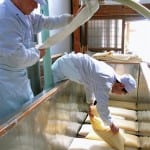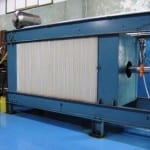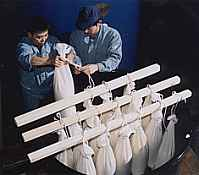 Bad puns notwithstanding, readers may recall that when making sake, after the typically three-to-five week long fermentation period during which rice is dissolving in the tank, and the resulting sugar is converted to alcohol, the sake at that point will be a white liquid, basically pure sake and rice solids remaining from the process. The remaining rice solids, lees as it were, need to be filtered out before the sake is bottled.
Bad puns notwithstanding, readers may recall that when making sake, after the typically three-to-five week long fermentation period during which rice is dissolving in the tank, and the resulting sugar is converted to alcohol, the sake at that point will be a white liquid, basically pure sake and rice solids remaining from the process. The remaining rice solids, lees as it were, need to be filtered out before the sake is bottled.
This is, clearly, a filtration. But since there are other filtration steps later that remove color and rough flavors, many refer to this step as “pressing.” So the just fermented mash is pressed through a mesh to yield clear, fresh sake.
There are basically three methods of pressing: by modern machine, by traditional box press, and by dripping out of cloth bags. You can learn much more about these three methods here, here and here.
But in short, the machine does a great job, and easily more than 99 percent of all sake made is pressed using a machine. The box press takes more time and effort, and the drip press takes even more.
In short, as one goes from machine to box to drip, the intensity and expressiveness of flavors and aromas of the resulting sake increase. So does cost, appropriately so. But yields, however, decrease, which is also hardly surprising.
 So going from machine to box to drip, the whole thing gets more extravagant. Based on this, one would naturally think that box pressed sake will in general be better than machine pressed sake, and drip pressed sake would in general be better than box pressed sake. So one would think that going from machine to box to drip is always better. But it ain’t.
So going from machine to box to drip, the whole thing gets more extravagant. Based on this, one would naturally think that box pressed sake will in general be better than machine pressed sake, and drip pressed sake would in general be better than box pressed sake. So one would think that going from machine to box to drip is always better. But it ain’t.
Why not? Because things are never that simple in the sake world. Never.
In spite of the above caveat, yes, most of the time drip-pressed sake – called shizuku – is the best stuff available. Wastefully extravagant and quite impactful (sometimes even downright intense) in flavors and aromas. This is usually what is sent to contests.
And the box-pressed stuff, pressed by laying meter-long tubular bags of filled with fermented mash into a wooden box and pressing the lid into that box, is next best. But this method too takes a lot of effort. Machine pressed sake is by far the most efficient to make – just plug and play. And while this is simplest, it tends to be the most staid.
The two “better” methods take longer than the machine. And that means that oxygen has more time to interact with the sake.
However, in recent years, the use of modern yeasts that create highly volatile aromatics have skewed this logic, at least in the opinion of some brewers. One such brewer is the energetic and animated (read: study-in-contstant-motion) Kosuke Kuji of Nanbu Bijin in Iwate Prefecture.
 Kuji-san uses a wide range of yeasts, but many of his sake make the most out of families of yeast that yield sake that are full of prominent apple, pineapple and licorice notes. These “modern yeasts” lead to sake that is full of esters which are quite volatile, in other words, they evaporate and disappear quickly in the presence of oxygen.
Kuji-san uses a wide range of yeasts, but many of his sake make the most out of families of yeast that yield sake that are full of prominent apple, pineapple and licorice notes. These “modern yeasts” lead to sake that is full of esters which are quite volatile, in other words, they evaporate and disappear quickly in the presence of oxygen.
As Kuji-san puts it, “If you are going to use a modern yeast, sake like that is as good as it is going to get right out of the press. From that moment on, it begins to degrade in a long, slow downhill slide. So for sake like that, a machine is best, as it gets the job done quickly and with a minimum of oxidation. One can get it into a bottle quickly, and lock all that great aroma inside.”
He continues on to explain that more traditional yeasts, like No. 7 and No. 9, have less capricious and more placid aromatic compositions. They are less sensitive to oxidation, but at the same time extravagant methods like box or drip pressing sharpen and brighten the flavors and aromas created by the those more traditional yeasts.
“The more classic yeasts,” he expounds, “lead to sake that has fewer ostentatious aromas to lose initially, and unlike sake made using modern yeasts, they get better after just a little time has passed. So for those, the box and drip offer something tangible.”
Certainly this is just one brewer’s opinion. A very accomplished and experienced brewer to be sure! But of course there are those in the industry, just as accomplished and experienced, that may completely disagree. Who knows?
There is a bit of a spin-doctor inside every good sake brewer. And any given spin-sensei may simply not want to bother with a hassle-laden method, and so spins a reason why it is not as good as the easy method. Happens all the time. In truth, it isprobably not the case in this particulr case here, but even in a 1000 year-old craft like sake brewing, there are marketers and spin doctors.
More importantly, though, among the three main methods of separating the sake lees from the completed ambrosia, dripping is usually the best, box-pressing next, and the machine press does a fine, fine job as well. But there are various opinions. Pressing matters, indeed.
~~~ ~~~ ~~~
The Sake Professional Course scheduled for April 23 to 25 in Brooklyn New York is full. Thanks to all those that signed up! The next one will be in Miami in September. If interested, please send an email to that purport to sakeguy @ gol.com. Learn more about the Sake Professional Course here.





